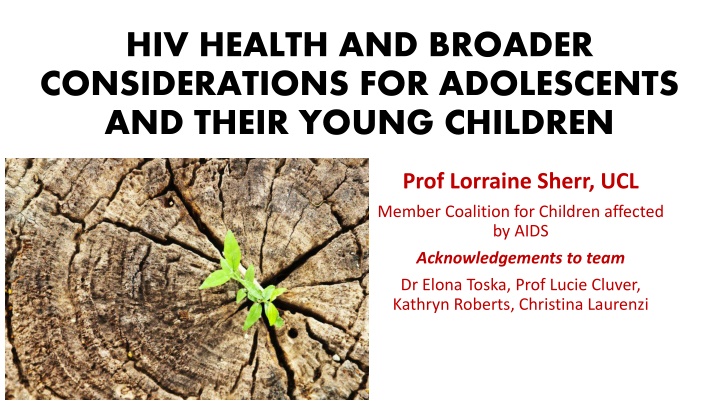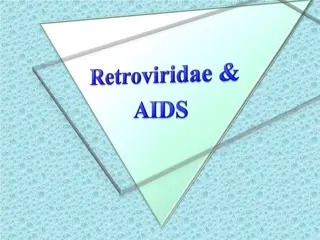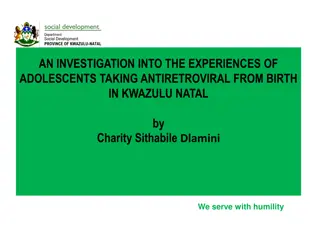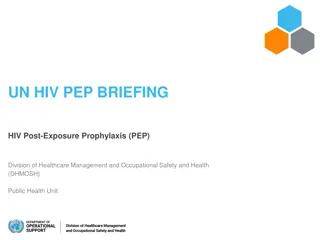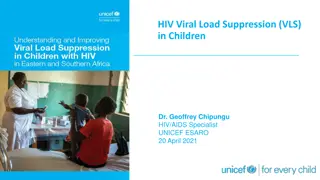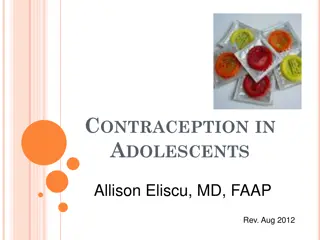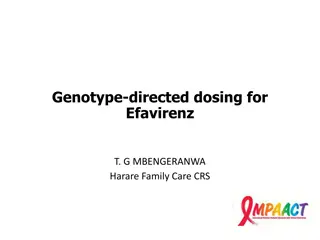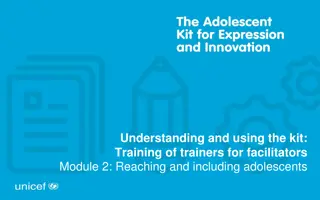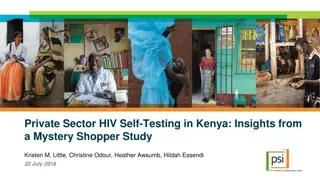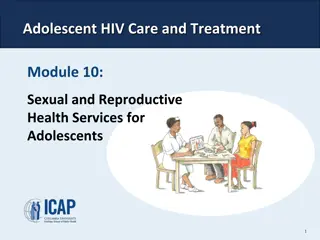HIV Health Considerations for Adolescents and Young Children
This presentation by Prof. Lorraine Sherr and team delves into the nuances of HIV/AIDS, teen pregnancy, and motherhood among adolescents in sub-Saharan Africa. It highlights the challenges faced by adolescent mothers and their children, emphasizing the multiple risk domains they navigate, such as physical and mental health, educational experiences, and socio-economic status. The setting is depicted with statistics on HIV prevalence, pregnancy rates, and postpartum complications, shedding light on the urgent need for supporting this vulnerable population.
Download Presentation

Please find below an Image/Link to download the presentation.
The content on the website is provided AS IS for your information and personal use only. It may not be sold, licensed, or shared on other websites without obtaining consent from the author.If you encounter any issues during the download, it is possible that the publisher has removed the file from their server.
You are allowed to download the files provided on this website for personal or commercial use, subject to the condition that they are used lawfully. All files are the property of their respective owners.
The content on the website is provided AS IS for your information and personal use only. It may not be sold, licensed, or shared on other websites without obtaining consent from the author.
E N D
Presentation Transcript
HIV HEALTH AND BROADER CONSIDERATIONS FOR ADOLESCENTS AND THEIR YOUNG CHILDREN Prof Lorraine Sherr, UCL Member Coalition for Children affected by AIDS Acknowledgements to team Dr Elona Toska, Prof Lucie Cluver, Kathryn Roberts, Christina Laurenzi
Rapid overview of relevant literature Pubmed Keyword Search! Toska, Roberts, Laurenzi, Cluver & Sherr 2019 180000 160000 153336 140000 120000 100000 90208 80000 60000 40000 20000 231 29 0 HIV/AIDS Teen pregnancy HIV/AIDS + Teen pregnancy Child
Pregnancy/childbearing during adolescence (10-19 years) Adolescent Adolescent HIV HIV motherhood motherhood Estimated 11.4 million adolescent mothers in sub-Saharan Africa Highest prevalence in the world 18.8% 1 Adolescent, Adolescent, Teen pregnancy, Teen pregnancy, HIV HIV Affected Affected High Burden High Burden Impact of HIV/HEU add a layer of complexity to the experiences of adolescents and their children
Multiple Multiple domains of risk domains of risk Physical health inc. sexual and reproductive health Mental health Cognitive health and development Educational experiences Socio-economic status Violence experiences Early childhood development
Setting the scene Adolescent mothers and their children SSA > risk of HIV and< receive or stay on treatment (Callahan et al 2017) Many adolescent mothers discover HIV status simultaneously with pregnancy confirmation (often late) (Ronen et al 2016) By age 18, 42% urban and 50% rural have become pregnant. (UNAIDS 2018) Adolescent mothers > risk postpartum complications Children of adolescent mothers are disadvantaged in nutrition and schooling (Cohorts n=22,188)( Fall et al 2015). Birth associated complications main cause of adolescent death globally. No studies on infant development of children born to HIV+ve adolescents Zero studies on HIV Adolescent mothers and postpartum risks.
Adolescents Adolescents infected and infected and affected by affected by HIV HIV Physical and mental health problems 4 ART non- adherence Low retention in care Neurocognitive delays 2,3 Mortality 5-9 More likely: Violence
Adolescents Adolescents mothers mothers with HIV with HIV Sexually-infected10 Elevated risk of HIV exposure for non-ALHIV 11 PMTCT Poor service engagement (antenatal/postnatal/ schooling/ECD) 12, 13
Maternal Maternal HIV & the HIV & the children of children of adolescents adolescents Structural & socio- economic issues Developmental outcomes (HIV/HEU) PMTCT Adherence
Mental health and adolescent pregnancy Mental health and adolescent pregnancy Anxiety, trauma, suicidal behaviours, (Casale et al 2019) isolation but +ve as well Depression elevated in adolescent pregnancy (Kenya) (Osok et al 2018). n=176, 32.9% Depression rate. Predictors HIV, young, absence of social support. Resilience, (but Borus 2019) 5 year fup none) meaning of life, coping, adjustment and fun.
Adolescent fathers: The forgotten half Largely excluded from the literature regarding pregnancy prevention, childbearing and HIV Limited evidence from sub-Saharan Africa Predictors of adolescent fatherhood include: lower levels of education greater number of sexual partners 14,15
Being a young mum is not a crime (Miriam) Focus on risk in the literature (Goossens et al 2015) Focus on negative in the literature Overall associated with low education, poorer prospects and repeated by generation But pregnancy may thwart academic achievement rather than the other way round (Wellings et al 1999). Negative outcomes may be linked to the correlates rather than the age. When the correlates are not present, the impact is ameliorated? Tackle the drivers Evidence gap go to where there is evidence, while prioritising the gathering of tailored evidence.
The Way forward The Way forward Age Things that work Exclusions Uncounted Unsupported Gender skew restricted access HEY Baby study Counting them Legal lens Make HIV services accessible Cash transfers/social protection Education bring them back into education Social Protection Integrated programming Mental health support Nurturing care ECD Provision Integration
HEY BABY STUDY TASTER FINDINGS HEY BABY STUDY TASTER FINDINGS 1,025 adolescent mothers (1/3 HIV+) and their children 51% had first child <18 years old 25% lived in rural areas 24% lived in informal housing 83% lacked basic necessities 28% did not have enough food at home in the past week for 3 meals a day 29% not in school even >1 year postpartum Higher suicidality and mental health issues potential syndemic of HIV & adolescent motherhood 6% never started ART during pregnancy 34% started after end of first trimester 10% stopped taking their ART during pregnancy/ breastfeeding
They Say in Africa THE LION ROARS TONIGHT DON T WAIT
1. Kassa GM, Arowojolu AO, Odukogbe AA, Yalew AW. Prevalence and determinants of adolescent pregnancy in Africa: a systematic review and Meta- analysis. Reprod Health. 2018. doi:10.1186/s12978-018-0640-2 Hoare J. The adolescent brain: understanding how youth perceive risks and healthcare needs. In: 21st International AIDS Conference - AIDS2016. Durban, South Africa; 2016. Sherr L, Croome N, Parra Castaneda K, Bradshaw K, Herrero Romero R. Developmental challenges in HIV infected children An updated systematic review. Child Youth Serv Rev. 2014;45:74-89. doi:10.1016/j.childyouth.2014.03.040 Lowenthal ED, Lawler K, Harari N, et al. Rapid psychosocial function screening test identified treatment failure in HIV+ African youth. AIDS Care Psychol Socio-medical Asp AIDS/HIV. 2012;24(6):722-727. Kariminia A, Law M, Davies MA, et al. Mortality and losses to follow-up among adolescents living with HIV in the IeDEA global cohort collaboration. J Int AIDS Soc. 2018. doi:10.1002/jia2.25215 Lamb MR, Fayorsey R, Nuwagaba-Biribonwoha H, et al. High attrition before and after ART initiation among youth (15-24 years of age) enrolled in HIV care. AIDS. 2014. Adolescent mothers affected by HIV and their children 34 doi:10.1097/QAD.0000000000000054 Dyer CEF, Campeau L, Toska E, Hodes R, Cluver LD. Are Youth Living with HIV in South Africa Reaching the Sustainable Development Goals?; 2019. Toska E, Cluver LD, Boyes ME, Isaacsohn M, Hodes R, Sherr L. School, Supervision and Adolescent-Sensitive Clinic Care: Combination Social Protection and Reduced Unprotected Sex Among HIV-Positive Adolescents in South Africa. AIDS Behav. 2016. doi:10.1007/s10461-016-1539-y Fairlie L, Sipambo N, Fick C, Moultrie H. Focus on adolescents with HIV and AIDS. South African Med J. 2014;104(12):897. doi:10.7196/SAMJ.9110 Ferrand RA, Corbett EL, Wood R, et al. AIDS among older children and adolescents in Southern Africa: projecting the time course and magnitude of the epidemic. AIDS. 2009;23(15):2039-2046. doi:10.1097/QAD.0b013e32833016ce Christofides NJ, Jewkes RK, Dunkle KL, Nduna M, Shai NJ, Sterk C. Early adolescent pregnancy increases risk of incident HIV infection in the eastern cape, south africa: A longitudinal study. J Int AIDS Soc. 2014;17:1-7. doi:10.7448/IAS.17.1.18585 Ronen K, McGrath CJ, Langat AC, et al. Gaps in Adolescent Engagement in Antenatal Care and Prevention of Mother-to-Child HIV Transmission Services in Kenya. J Acquir Immune Defic Syndr. 2016;ahead of p. doi:10.1097/QAI.0000000000001176 Orne-Gliemann J, Font H, Maphosa T, et al. Patterns of Attendance at Mother Support Groups in Zimbabwe. The EPAZ Trial (2014 2016). JAIDS J Acquir Immune Defic Syndr. 2017;75:S216-S223. doi:10.1097/QAI.0000000000001348 Odimegwu CO, Amoo EO, De Wet N. Teenage pregnancy in South Africa: Where are the young men involved? SAJCH South African J Child Heal. 2018. doi:10.7196/SAJCH.2018.v12i2.1523 Amoo EO, Igbinoba A, Imhonopi D, et al. Trends, Determinants and Health Risks of Adolescent Fatherhood in Sub-Saharan Africa. Ethiop J Health Sci. 2018;28(4):433-442. doi:10.4314/ejhs.v28i4.9 Nuwagaba et al (2018) Adolescent pregnancy at antiretroviral terapy initiation: a critical barrier to retention on ART JINT AIDS Soc Sept21(9)e25178 Osok et al (2018) BMC Psychiatry Depression and its psycosocial risk factors in pregnant Kenya adolescents Vol 18,18(1);36 2. 3. 4. 5. 6. 7. 8. 9. 10. 11. 12. 13. 14. 15. 16. 17.
